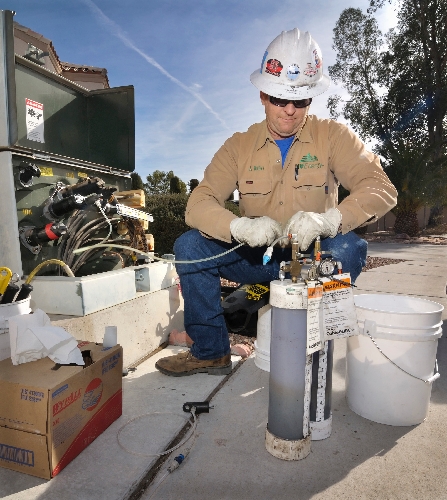NV Energy turns to CableCURE to give their lines longer life

More reliable power service and hundreds of millions of dollars in savings?
That might sound impossible, but NV Energy says a simple cable treatment has brought both to Southern Nevada. The utility is repairing its buried cables with CableCURE, a silicon-based liquid that the company says will extend cable life for decades. As of early January, when the utility reached the milestone of 5 million feet of line treated with CableCURE, it had saved NV Energy and its ratepayers around
$300 million over 12 years, according to NV Energy and UtilX, the Washington company that provides the technology.
NV Energy officials say they’ve spent about
$35 million on CableCURE injection, or about a tenth of what it would have cost to dig up and replace old lines.
Think of it as a rate increase the company never had to ask for, said Mark Shank, executive of NV Energy’s electric operations in Southern Nevada.
“If we had to replace those cables, it would put upward pressure on power bills,” Shank said.
In utility terms, $300 million is significant. The company must by law file general rate cases every three years. Its most recent case, decided in December, got the company $158.6 million a year in added annual revenue on a $2.2 billion base, for an increase of 3.5 percent, or $4.84, in the average local monthly power bill.
Few utilities have gotten as much out of the technology as NV Energy, said Jack Stel, president and CEO of UtilX.
UtilX injected about 7.5 million feet of line in the United States in 2011. About 10 percent of that, or 750,000 feet, were in NV Energy territory. UtilX has worked with 300 U.S. utilities, including most of the country’s 50 biggest power companies, and has helped 500 utilities worldwide refurbish lines. NV Energy, at 5 million feet, is the third-largest user in the world. Only Florida Power & Light (7.5 million feet) and Arizona’s Salt River Project (6 million feet) have revitalized more power cable with the technology. And with 9 million more feet to go, for a total of 14 million feet by 2018, NV Energy will likely stay in the top five, Stel said.
Shank said NV Energy has deployed so much of the technology because, well, it works.
Here’s how:
As cables installed in the ’70s and ’80s approach 20 years in service, their plastic coating cracks, allowing water to short out an average of nearly 400 feet of cable at a time and knocking out service to whole neighborhoods
Technicians tap a cracked cable and inject CableCURE, which is thinner and more slippery than water, through the length of the cable to fill cracks and reinsulate the wire. The failure rate of rejuvenated lines is 0.6 percent, about the same as new cables. The refreshed lines have a 20-year warranty, but Stel and Shank said they expect the cables to last longer.
Since NV Energy began using CableCURE, the utility’s reliability has skyrocketed, Shank said. There are four times fewer line failures today than a decade ago. A recent survey from the Electric Power Research Institute ranked NV Energy No. 1 among more than 60 investor-owned utilities for service reliability. And car accidents have supplanted cable failures as the top cause of power outages in Southern Nevada.
But perhaps most importantly, CableCURE has saved locals untold amounts of aggravation, Shank said.
“We know how upset people get when they’re driving around their neighborhoods and their streets, driveways and landscaping are torn up,” Shank said. “Not having to tear up their yards has been a huge benefit to our customers. We’ve avoided that inconvenience.”
Contact reporter Jennifer Robison at
jrobison@reviewjournal.com or 702-380-4512.